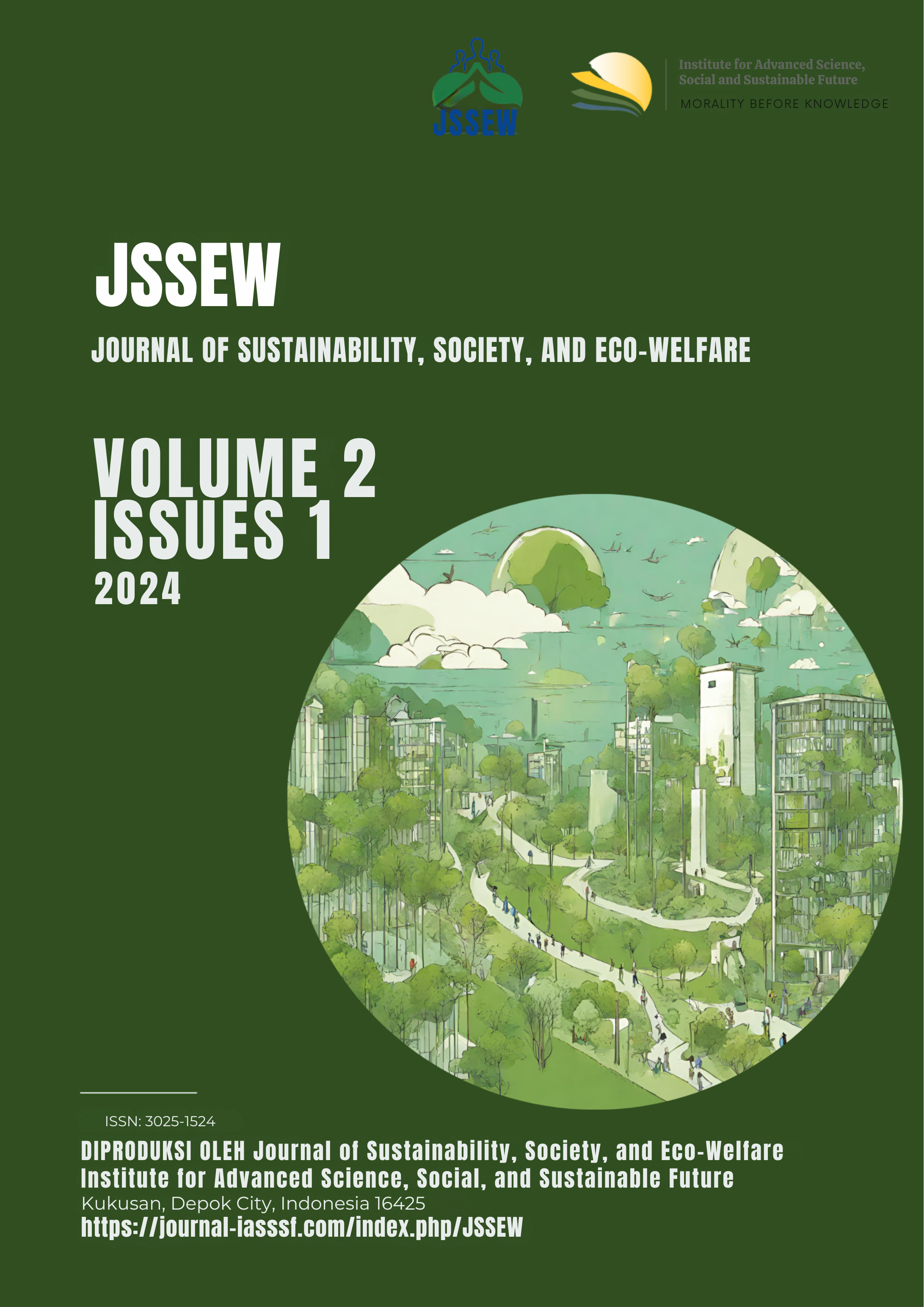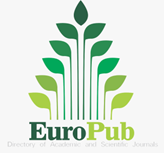Biophysics indicators as the sustainable strategy for river pollution control: Case study in Jangkok River, Mataram City, West Nusa Tenggara
DOI:
https://doi.org/10.61511/jssew.v2i1.2024.943Keywords:
behavior, perception, pollution control, river water quality, settlement conditions, stakeholder involvementAbstract
Background: Sungai Jangkok is one of those considered heavily polluted in West Nusa Tenggara/Nusa Tenggara Barat (NTB), Indonesia. The Biochemical Oxygen Demand (BOD) value has exceeded the Class II water quality standard, and according to the Family Biotic Index (FBI) value, the river falls under the category of heavy organic pollution. The research objective is to realize sustainable management of the Jangkok Watershed by its river functions by implementing pollution control strategies. Methods: Data was collected using questionnaires and interviews with the public and stakeholders (government and NGOs). Water quality data was obtained from DLHK NTB and DLH Mataram City, and sampling was carried out using the composite sample technique. The methods employed were STORET, QUAL2Kw, logistic regression, and SWOT. Findings: The research findings indicate that, in general, the Jangkok River in Mataram City falls into the heavily polluted category from 2015 to 2022, with an average STORET score of -79.25. Moreover, the pollution loads of BOD, COD, and TSS entering the river have exceeded the pollution-carrying capacity. The condition is influenced by several factors, including the less favorable perception of pollution status (67%) and the usefulness of the river (59%) by the community. Additionally, the persistent behavior of littering and defecating in the river (23%), inadequate preventive practices (59%), insufficient wastewater disposal facilities (40%), and improper waste management (58%) are contributing factors. Moreover, houses backing up to the river (59%) also play a role in the current condition. Some causes are the need for more synergy across administrative regions between stakeholders, the absence of law enforcement for the community, dependency on the government budget for work programs, and the lack of incentives. Conclusion: The conclusion of this research suggests that the most effective strategy for taking is to develop a program for reducing pollutant loads that is integrated across districts and cities, integrated across agencies with various levels of authority, integrated with the community, and by the river's actual conditions and the socioeconomic community. Novelty/Originality of this Study: This study provides a novel approach by integrating quantitative water quality modeling (QUAL2Kw) with community behavior analysis to develop a sustainable and comprehensive strategy for controlling river pollution in the Jangkok watershed, Mataram City.
References
Al-Omari, A., Farhan, I., Kandakji, T., & Jibril, F. (2019). Zarqa river pollution: impact on its quality. Environmental Monitoring and Assessment, 191(3). https://doi.org/10.1007/s10661-019-7283-9
Albuquerque, M. T. D., & Pelletier, I. M. H. R. A. N. P. O. G. (2019). Impact of sewage effluent discharges prediction using QUAL2Kw in a sensitive protected area: Portugal. SN Applied Sciences, 1(10), 1-8. https://doi.org/10.1007/s42452-019-1095-y
Antunes, I. M. H. R., Albuquerque, M. T. D., Oliveira, S. F., & Sánz, G. (2018). Predictive scenarios for surface water quality simulation - a watershed case study. Catena, 170(February), 283-289. https://doi.org/10.1016/j.catena.2018.06.021
Belinawati, R. A. P., Soesilo, T. E. B., Herdiansyah, H., & Aini, I. N. (2018). BOD pressure in the sustainability of the Citarum river. E3S Web of Conferences, 52, 1-8. https://doi.org/10.1051/e3sconf/20185200037
BPS. (2019). West Nusa Tenggara province in figures 2020. Mataram: BPS NTB.
Chasna, R. (2016). Analysis of pollution load capacity using QUAL2Kw software (case study: Code River, Yogyakarta). Environmental Engineering, Islamic University of Indonesia.
Djoharam, V., Riani, E., & Yani, M. (2018). Analysis of water quality and pollution load capacity of Pesanggrahan river in the DKI Jakarta province region. Journal of Natural Resources and Environmental Management, 8(1), 127-133. https://doi.org/10.29244/jpsl.8.1.127-133
DLHK NTB. (2019). Strategic plan (Renstra) of the Environment and Forestry Agency of West Nusa Tenggara Province for 2018-2023. Mataram: DLHK NTB.
Garg, T., Hamilton, S. E., Hochard, J. P., Kresch, E. P., & Talbot, J. (2018). (Not so) gently down the stream: River pollution and health in Indonesia. Journal of Environmental Economics and Management, 92, 35–53. https://doi.org/10.1016/j.jeem.2018.08.011
Ghorbani Mooselu, M., Nikoo, M. R., & Sadegh, M. (2019). A fuzzy multi-stakeholder socio-optimal model for water and waste load allocation. Environmental Monitoring and Assessment, 191(6). https://doi.org/10.1007/s10661-019-7504-2
Guerreiro, M. S., Abreu, I. M., Monteiro, Á., Jesus, T., & Fonseca, A. (2020). Considerations on the monitoring of water quality in urban streams : a case study in Portugal. Environmental Monitoring and Assessment, 197, 357.
Hairan, M. H., Jamil, N. R., Looi, ley J., & Azmai, M. N. A. (2021). The assessment of environmental fl ow status in Southeast Asian Rivers : A review. Journal of Cleaner Production, 295, 126411. https://doi.org/10.1016/j.jclepro.2021.126411
Harris, P. T., Westerveld, L., Nyberg, B., Maes, T., Macmillan-Lawler, M., & Appelquist, L. R. (2021). Exposure of coastal environments to river-sourced plastic pollution. Science of the Total Environment, 769, 145222. https://doi.org/10.1016/j.scitotenv.2021.145222
Herzog, L. M., & Ingold, K. (2019). Threats to Common-Pool Resources and the Importance of Forums : On the Emergence of Cooperation in CPR Problem Settings. Policy Studies Journal, 0(0), 1–37. https://doi.org/10.1111/psj.12308
Hlordzi, V., Kuebutornye, F. K. A., Afriyie, G., Abarike, E. D., Lu, Y., Chi, S., & Anokyewaa, M. A. (2020). The use of Bacillus species in maintenance of water quality in aquaculture: A review. Aquaculture Reports, 18, 100503. https://doi.org/10.1016/j.aqrep.2020.100503
Horton, A. A., & Barnes, D. K. A. (2020). Microplastic pollution in a rapidly changing world: Implications for remote and vulnerable marine ecosystems. Science of the Total Environment, 738, 140349. https://doi.org/10.1016/j.scitotenv.2020.140349
Hou, S., Xu, J., & Yao, L. (2020). Integrated environmental policy instruments driven river water pollution management decision system. Socio-Economic Planning Sciences, November, 100977. https://doi.org/10.1016/j.seps.2020.100977
Idrus, S. W. Al. (2015). Analysis of water pollution using a simple method in the Jangkuk, Kekalik, and Sekarbela rivers of Mataram city. Pijar MIPA Journal, 10(1), 37-42. https://doi.org/10.29303/jpm.v10i2.28
Indriyani, K., Hasibuan, H. S., & Gozan, M. (2021). Social conditions in wastewater processing to manage river water quality (study in Cirarab River, Tangerang District, Indonesia). IOP Conference Series: Earth and Environmental Science, 623(1). https://doi.org/10.1088/1755-1315/623/1/012050
Jama, O. M., Lu, G., Diriye, A. W., Yousaf, B., Basiru, I., & Abdi, A. M. (2020). Participation of civil society in decisions to mitigate environmental degradation in post-conflict societies : evidence from Somalia. Journal of Environmental Planning and Management, 0(0), 1–21. https://doi.org/10.1080/09640568.2019.1685957
Jiang, H., Zhang, Q., Liu, W., Zhang, J., Pan, K., Zhao, T., & Xu, Z. (2021). Isotopic compositions reveal the driving forces of high nitrate level in an urban river: Implications for pollution control. Journal of Cleaner Production, 298, 126693. https://doi.org/10.1016/j.jclepro.2021.126693
Kang, G., Qiu, Y., Wang, Q., Qi, Z., Sun, Y., & Wang, Y. (2020). Exploration of the critical factors influencing the water quality in two contrasting climatic regions. Environmental Science and Pollution Research, 27(11), 12601-12612. https://doi.org/10.1007/s11356-020-07786-5
Kim, J. J., & Ryu, J. H. (2020). Decision-making of LID-BMPs for adaptive water management at the Boise River watershed in a changing global environment. Water (Switzerland, 12(9). https://doi.org/10.3390/w12092436
KLHK. (2019). Performance report of the Directorate General for Pollution Control and Environmental Damage. Jakarta: Ministry of Environment and Forestry of the Republic of Indonesia.
Manalu, Y. S. (2022). QUAL2KW application guide version 5.1.
Marganingrum, D., Djuwansah, M. R., & Mulyono, D. A. N. A. (2018). Assessment of the capacity of Jangkok River and Ancar River to handle organic pollutants. Journal of Environmental Technology, 19(1), 71-80. https://doi.org/10.29122/jtl.v19i1.1789
Mgelwa, A. S., Hu, Y. L., & Ngaba, M. J. Y. (2020). Patterns of nitrogen concentrations and their controls in two southern China urban river ecosystems. Global Ecology and Conservation, 23, 01112. https://doi.org/10.1016/j.gecco.2020.e01112
Oliveira, B., Bola, J., Quinteiro, P., Nadais, H., & Arroja, L. (2012). Application of Qual2Kw model as a tool for water quality management: Cértima river as a case study. Environmental Monitoring and Assessment, 184(10), 6197-6210. https://doi.org/10.1007/s10661-011-2413-z
Saily, R., & Setiawan, B. (2021). Determination of carrying and load capacity using QUAL2Kw modeling simulation. IOP Conference Series: Earth and Environmental Science, 737(1). https://doi.org/10.1088/1755-1315/737/1/012022
Shaleh, F. R., Prihatini, E. S., & Masud, F. (2021). Analysis of water pollution in Kaliotik river, Lamongan-West Java. IOP Conference Series: Earth and Environmental Science, 744(1). https://doi.org/10.1088/1755-1315/744/1/012075
Sugiyarto, Hariono, B., Destarianto, P., & Nuruddin, M. (2018). Determination of water quality status at Sampean Watershed Bondowoso residence using Storet method. Journal of Physics: Conference Series, 012126.
Susilowati, Y., Kumoro, Y., & Nur, W. H. (2020). Integrated water quality modeling for spatial planning. IOP Conference Series: Earth and Environmental Science, 483(1). https://doi.org/10.1088/1755-1315/483/1/012041
Xu, X., Wu, F., Zhang, L., & Gao, X. (2020). Assessing the effect of the Chinese River Chief policy for water pollution control under uncertainty - using Chaohu Lake as a case. International Journal of Environmental Research and Public Health, 17, 3103. https://doi.org/10.3390/ijerph17093103
Downloads
Published
How to Cite
Issue
Section
Citation Check
License
Copyright (c) 2024 Journal of Sustainability, Society, and Eco-Welfare

This work is licensed under a Creative Commons Attribution 4.0 International License.

















